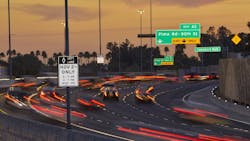Public transportation agencies aim to improve their constituents’ safety while maintaining a rapid and efficient transportation infrastructure. Traffic signs are an important element of this roadway infrastructure, aimed to provide valuable and timely information to drivers. Although ensuring that the traffic signs provide this valuable and timely information will not eliminate crashes, failing to provide the timely and accurate information to drivers will almost certainly lead to severe inefficiencies if not further crashes.
Recent studies have investigated requirements for sign brightness that allow for quick yet accurate information acquisition. Findings suggest that larger signs and increased brightness provide for faster information acquisition by the driver. Furthermore, sign improvement programs suggest that crash reductions are possible with systematic sign upgrades.
The City of Albuquerque, New Mexico, has upgraded its traffic signs in multiple sections of the city. The city has been replacing all traffic signs district by district, which allowed researchers from the Texas Transportation Institute (TTI) to have control sites alongside treatment (sign upgrade) sites. The study reports on the crash frequencies not only before-and-after the treatment in districts that have undergone sign upgrades, but also with districts with no sign upgrades, serving as control sites. Findings indicate that, when viewed collectively as a systemic treatment, the upgraded signs may have contributed to reducing as many as 13 nighttime crashes across the entire collection of the treated segments.
Download the full report
Editor's Note: Scranton Gillette Communications and the SGC Infrastructure Group are not liable for the accuracy, efficacy and validity of the claims made in this piece. The views expressed in this content do not reflect the position of the Roads & Bridges' Editorial Team.
